Gelsemium sempervirens is the Botanical name for the Yellow Jessamine. This is an attractive climbing plant with a twining habit which means the stems twine around objects so the plant can reach higher. It is an evergreen best suited for temperate and warmer climates, and has masses of small yellow flowers in Spring, which look great against the glossy deep green leaves, and the flowers have a lovely fragrance. Yellow Jessamine is also the state flower of South Carolina in the USA. The nectar from the flowers attracts birds and other pollinators, but all parts of the plant are toxic to humans.
You can grow this plant on a trellis or pergola for privacy, or to hide a wall, or also in pots ,with a support in place for the plant. Plant it in a sunny spot for the best flower display, and it will grow quite quickly. This plant was growing in a Sydney garden where it enjoyed the heat from a brick wall. 
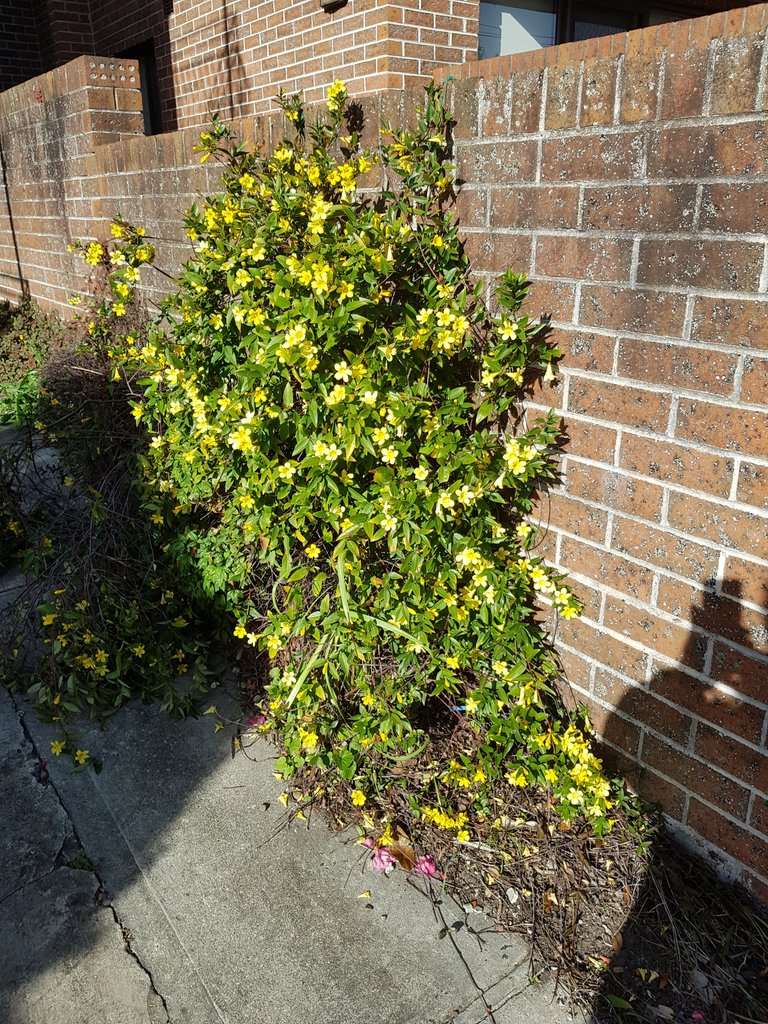
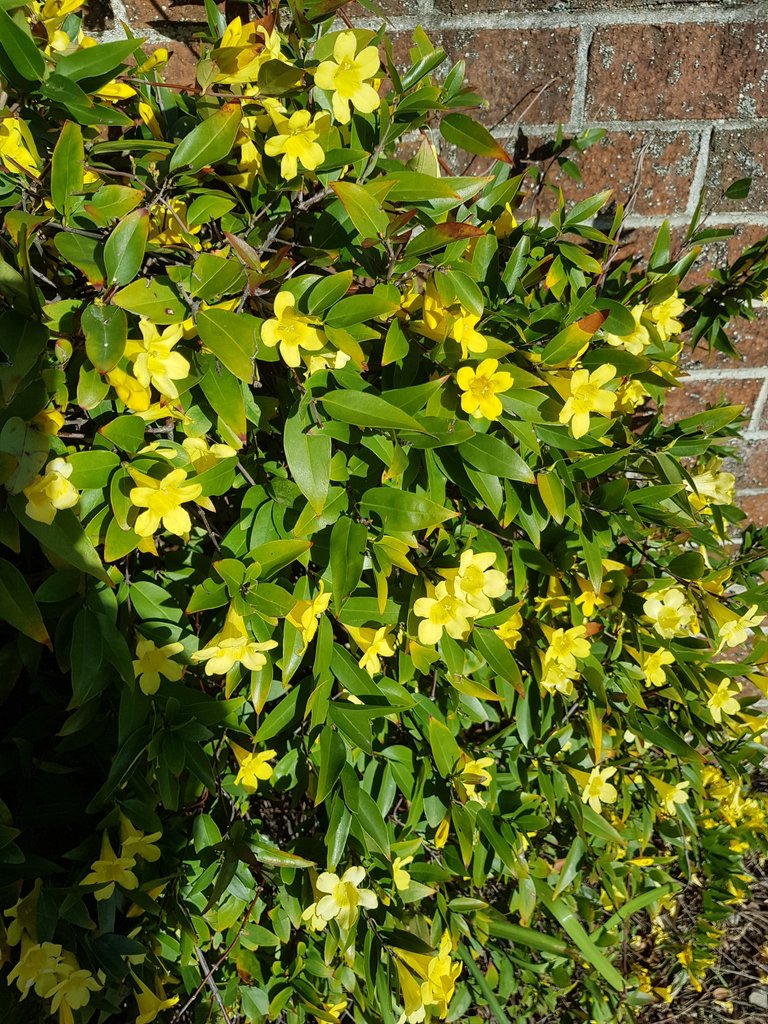
Yellow jessamine is a climbing vine that is native to the southeastern United States. It is known by several names, including Carolina jessamine, poor man's rope, or yellow jasmin. It has also been known as "The Pride of Augusta," because it is found abundantly near Augusta, Georgia. Yellow jessamine is the state flower of South Carolina and it appears on that state's quarter along with the Carolina wren and the cabbage palmetto.
Yellow jessamine is particularly noticeable because it has showy, yellow flowers that appear in late winter or early spring when few other plants are in bloom. In some strains of the plant, the flowers are very fragrant and send a sweet, prevailing scent through the wintery woods.
http://www.sfrc.ufl.edu/extension/4h/plants/Yellow_jessamine/index.html
Fav. comment Award ! Well chosen Pics ! Thanks.
Yellow jessamine (Gelsemium sempervirens) is the South Carolina State Flower. Yellow jessamine bloom on a high-climbing, woody vine. Yellow jessamine plant is a landscape plant.Yellow jessamine flowers are clusters of bright yellow, fragrant, tubular blossoms, with flared petals. Yellow jessamine bloom from December to March.
Yellow Jessamine is called by several names like Carolina jessamine, poor man's rope, or yellow jasmine and as The Pride of Augusta, Evening Trumpetflower, Gelber Jasmin, Jasmin sauvage, Sariyasemin . Yellow Jessamine's characteristic feature is its sweet, prevailing scent through the wintery woods. Yellow Jessamine is common in the coastal plains and Piedmont regions from Virginia to South Florida and west to Arkansas and Texas.
Source: https://www.theflowerexpert.com/content/aboutflowers/stateflowers/south-carolina-state-flowers
Yellow jessamine (Gelsemium sempervirens) became our official state flower in March 14,1924. Because it is native to our state, it is also called Carolina jessamine. Other names include trumpet vine, evening trumpet flower, and both yellow jasmine and Carolina Jasmine. (Jessamine and jasmine are two variations of the same word, and both are acceptable and accurate names for this plant. Here we refer to it as jessamine since that is how it is spelled in Joint Resolution No. 534, which established the flower as an emblem of South Carolina nearly a century ago.)
Jessamine is an evergreen vine that climbs trees, fences, and latticework all over our state. It blooms in very late winter or early spring, offering the first hope of warm weather to come! This flower loves sun and can grow quite fast given plenty of space and moist, well-drained soil.
https://www.sciway.net/facts/sc-state-flower-yellow-jessamine.html
Very bright yellow flowers with perfume too! I really must have a look for this yellow jasmine in Bangkok! This is the first time I have heard of this type of jasmine!
Posted using Partiko iOS
Actually, it's not really a Jasmine, although "Jessamine" is close to it, and it is fragrant like a Jasmine too.
LOL. This just shows how the mind refused to see the fact tughtbin front and preferred to translate according to what’s familiar!
Yes, I did see Jessamine but I thought it was just another name for common jasmine with yellow colour! Nice to know that the flowers has the same jasmine fragrance.
Interesting, beautiful and very useful for human plants. Gelsemium SEMPERVIRENS - Evergreen Gelsemia.
Virginia or yellow jasmine, Jasmine Carolina.
Very popular in landscaping liana. Blooms profusely in early spring, the flowers are bright, fragrant. Helzemia is recognized as the state flower of South Carolina. Widely used in medicine.
A fast-growing evergreen woody vine, with thin twisting branches.
Leaves are supremely full lanceolate leathery, dark green shiny, up to 10 cm long.
The flowers are bright yellow, very fragrant, up to 5 cm long, collected in dense inflorescences. Corolla right bell-shaped five-bladed. Its fragrant flowers are among the earliest in spring.
http://adenium-doma.ru/shop/781/desc/gelsemium-sempervirens
I saw this plant at my country! I think it's common here! And also famous in gardening as well! Stunning photography and description! Your botanical knowledge is extremely useful for all of us to get a clear idea about what we should plant in our garden! Really appreciate it!@ctrl-alt-nwo,
Cheers~
That's looks so elegant great to know about this plant really fascinating it was :)
wow you get really A LOT of comments!! that is awesome man!
here is my little comment without much information of these plants but FULL OF GOOD VIBES!! because you know... life is beautiful!! and we have to live it at 100%
wow it's been so long since i saw yellow Jessamine and those are looking just great , look like you are taking good care of them
Very beautiful weaving plant. Her yellow flowers look great Respect.
Greetings @ctrl-alt-nwo That was such a beautiful flowers,i always love those flowers with fragrances.
Is that flowers will vine also to the ground?
They can grow on the ground, until they find something to climb !
ohw..that was great,that plants look familiar but the flower are in different shapes..
outstanding as always..plse. see the lates just up..very bullish indeed for the metals..thnx.
Yellow Jessamine - exceptionally delicate and wonderfully composed in beautiful gardens. They give so much joy with their miniature flowers. :)
Greetings my friend
The yellow Carolina jasmine (or "jessamine") is an attractive evergreen vine that tends to remain bushy and compact when grown in bright sun. When shaded though, it will climb up and over adjacent shrubs and trees to heights of more than 20 ft (6.1 m) in its quest for sunlight. The glossy rich green leaves are narrow oblongs with pointed tips and are 2-3 in (5.1-10.2 cm) long by 0.5 in (1.3 cm) wide.

They are held in opposite pairs along smooth wiry reddish-brown stems. Small clusters of fragrant yellow tubular flowers are produced from late winter to early spring depending on location and temperature. The showy blossoms are about 2 in (5.1 cm) long and have a flared mouth 1 in (2.5 cm) in diameter.
Gelsemium sempervirens is native to the southeastern United States. Carolina jasmine is widely grown as an ornamental in mild climate areas.
Usage
Carolina jasmine will rapidly cover arbors, tree trunks, trellises, etc. in a season or two. This is a well behaved vine that will stay in scale and can be used on decks and porches and on trellises near patios and entryways. It grows well in containers and as ground cover along steep banks. Carolina jasmine is a good candidate for low maintenance landscapes.
This fast growing evergreen vine is easy to grow and readily available. The sight of Carolina jessamine's (a variant spelling of "jasmine") happy yellow flowers is one of our first signs of spring. The wiry reddish brown stems are flexible and inspire another common name for this vine,"poor man's rope" (because it breaks easily so only poor men use it)
References12345
Thanks again for sharing.
Shared on twitter promoting good quality content on #Steemit.
Stephen
#Promo-Steem #steemtalent #JoinSteemit #Steemit
Yellow Jessamine. #STEEM #steemtalent #JoinSteemit #Steemit @Steemit
#Gardens #Gardening #Plants #Photography #Photographer #Blogging #Blogger #Australia
This is a nice plant to have for a shade @ctrl-alt-nwo because of its thick leaves along with beautiful yellow flowers.
The beautiful Jessamine love the warm walls👍
Lively attractive climber.
Well they do really look beautiful and I have seen them as well ;)
They sure are a beauty to watch by the way.
all those yellow in between green does really makes it even more beautiful.
Carolina jessamine (Gelsemium sempervirens) is one of the most beautiful vines of the South. It covers fences and trees in open woodlands and along roadsides throughout the Southeast with its slender vines and bright yellow flowers. It is the state flower of South Carolina.
Sweetly scented, golden yellow flowers cover the cascading, fine textured foliage from February to April. The trumpet-shaped blooms have 5 lobes, are 1 to 1½ inches long, and are attractive to both butterflies and bumblebees. The shiny evergreen leaves are 1 to 3 inches long on 10-to-20-foot tall vines.
Carolina jessamine is easy to grow. It is attractive on an arbor where the slender branches hung with yellow flowers can be seen from below. This plant will stay in scale and can be used on decks and porches and near patios and entryways. It is good in containers and as a ground cover along steep banks to help control erosion.
https://hgic.clemson.edu/factsheet/carolina-jessamine/
Your post was mentioned in the Steemit Hit Parade in the following category:Congratulations @ctrl-alt-nwo!
Family: Gelsemiaceae
Genus: Gelsemium (jel-SEM-ee-um) (Info)
Species: sempervirens (sem-per-VY-renz) (Info)
Synonym: Bignonia sempervirens
Synonym: Gelsemium lucidum
Synonym: Gelsemium nitidum
Synonym: Jeffersonia sempervirens
source
Yellow jessamine (Gelsemium sempervirens) became our official state flower in March 14,1924. Because it is native to our state, it is also called Carolina jessamine. Other names include trumpet vine, evening trumpet flower, and both yellow jasmine and Carolina Jasmine. (Jessamine and jasmine are two variations of the same word, and both are acceptable and accurate names for this plant. Here we refer to it as jessamine since that is how it is spelled in Joint Resolution No. 534, which established the flower as an emblem of South Carolina nearly a century ago.
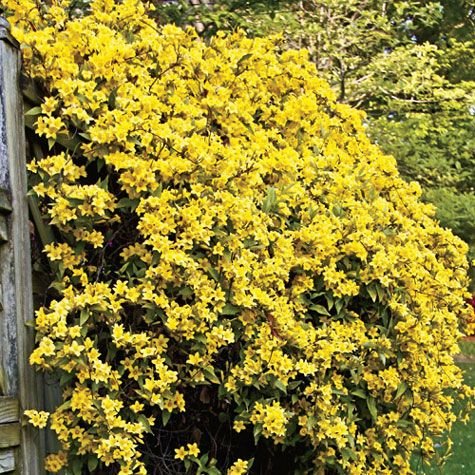
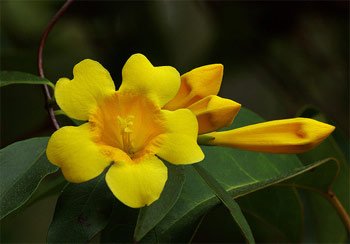
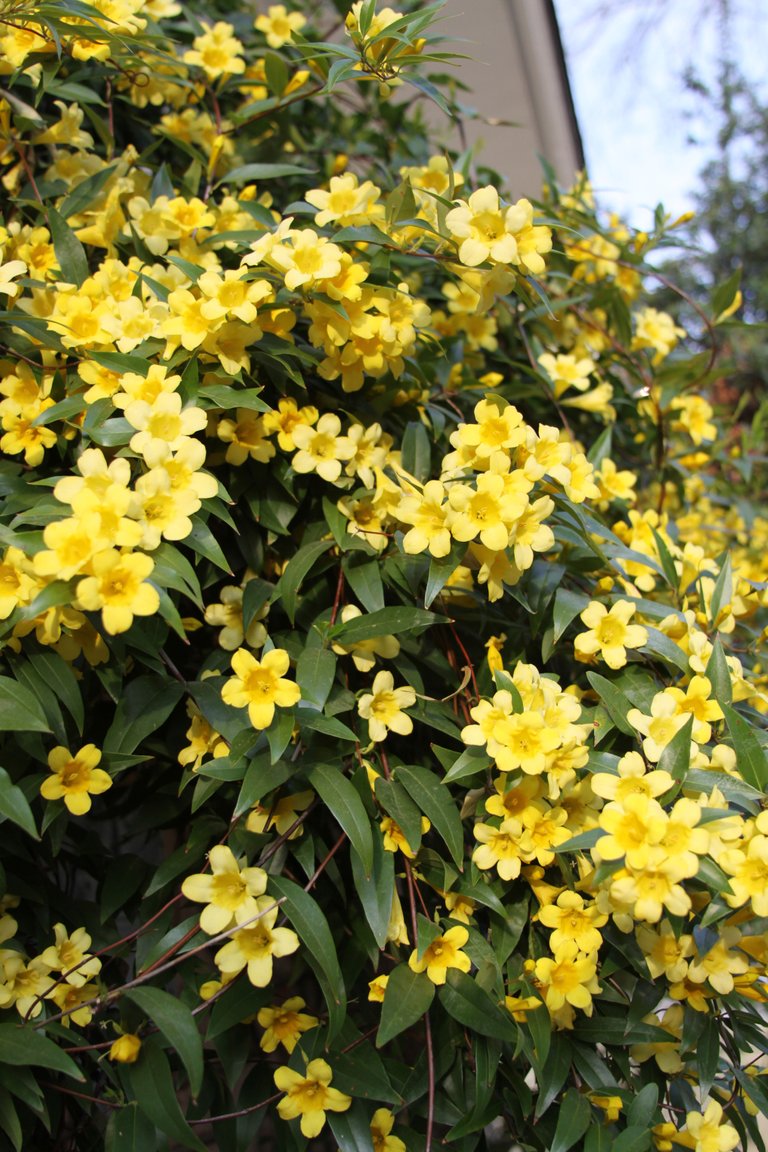
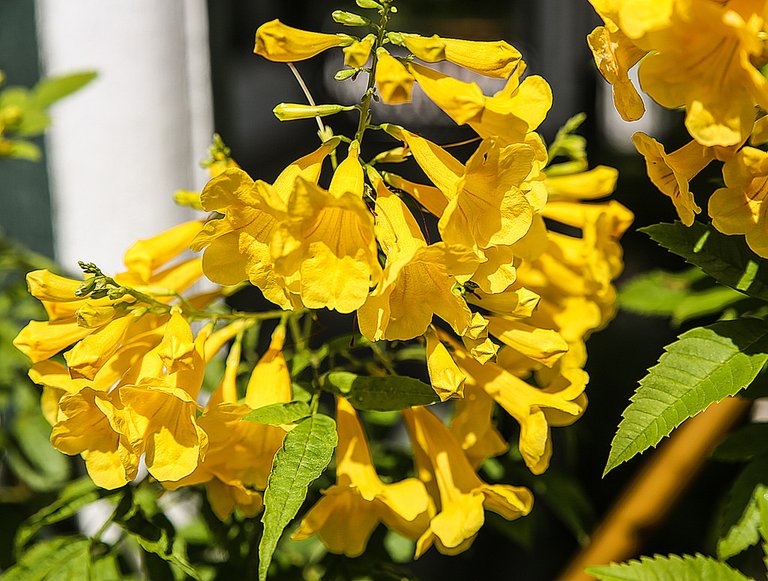 9
9
Jessamine is an evergreen vine that climbs trees, fences, and latticework all over our state. It blooms in very late winter or early spring, offering the first hope of warm weather to come! This flower loves sun and can grow quite fast given plenty of space and moist, well-drained soil.
When the US Mint decided to release quarters for each of the states, it was decided that Yellow Jessamine would appear on South Carolina's quarter, along with the palmetto tree and the Carolina Wren (our state bird).
Source.
Spring season always bring the beauty to our surroundings because genuinely it reflects as nature becomes more lively in the Spring season. And yellow flowers cannot hide from eyes because these holds the different eye-catching effect.@ctrl-alt-nwo, In my opinion
In my opinion, for this plant Brick Wall is suiting. And it's reflecting as these flowers are naturally sticked to the wall and it's reflecting as these are decorated on these Brick Walls. I am sure that whoever will watch this, they will going to get the Inspiration to plant these kind of breathtaking and beautiful plants.
Wishing you an great day and stay blessed. 🙂
Super. It also would look great if too lazy to repaint a wall :-)
Gelsemium sempervirens
Growth
Carolina jasmine or Carolina jessamine -- Gelsemium sempervirens
Gelsemium sempervirens can grow to 3–6 m (9.8–19.7 ft) high when given suitable climbing support in trees, with thin stems. The leaves are evergreen, lanceolate, 5–10 cm (2.0–3.9 in) long and 1–1.5 cm (0.39–0.59 in) broad, and lustrous, dark green. The flowers are borne in clusters, the individual flowers yellow, sometimes with an orange center, trumpet-shaped, 3 cm (1.2 in) long and 2.5–3 cm (0.98–1.18 in) broad. Its flowers are strongly scented and produce nectar that attracts a range of pollinators.[3]
Medical use Edit
Historically Gelsemium sempervirens was used as a topical to treat papulous eruptions. It was also used to treat measles, neuralgic otalgia, tonsillitis, esophagitis, dysmenorrhea, muscular rheumatism, headaches.[8]
https://en.m.wikipedia.org/wiki/Gelsemium_sempervirens
Yellow jessamine (Gelsemium sempervirens) is the official flower of the state of South Carolina that was established in 1924.
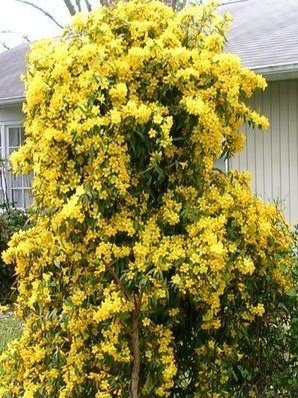
Jessamine was found throughout South Carolina and "the soft flowers show the purity of gold; the return of eternal winter shows the lesson in deep determination, loyalty and deception." patriotism State service "(quote from the South Carolina legislature). Yellow jessamine was also displayed in the South Carolina quarter.
Yellow jessamine is an annual plant that always lives from native vines in the southeastern United States (sometimes referred to as "Carolina jasmine"). Beautiful but all parts of the plant are toxic.
Source
Gelsemium sempervirens is utilized in homeopathy for treating patients with tension related side effects, anyway there have been couple of test considers assessing its pharmacological movement. We have explored the impacts of homeopathic measurements of G. sempervirens on mice, utilizing approved social models. Centesimal (CH) weakenings/dynamizations of G. sempervirens, the reference sedate diazepam (1 mg/kg body weight) or a fake treatment (dissolvable vehicle) were intraperitoneally conveyed to gatherings of mice of CD1 strain amid 8 days, at that point the impacts were surveyed by the Light-Dark (LD) decision test and by the Open-Field (OF) investigation test, in a completely visually impaired way. In the LD test, the interim spent in the lit up zone by control and fake treatment treated creatures was 15.98%, for mice treated with diazepam it expanded to 19.91% (P = .047), while with G. sempervirens 5 CH it was 18.11% (P = .341, non-noteworthy). The quantity of changes between the two compartments expanded with diazepam from 6.19 to 9.64 (P < .001) however not with G. Sempervirens. In the OF test, G. sempervirens 5 CH fundamentally expanded the time spent and the separation went in the focal zone (P = .009 and P = .003, resp.), while diazepam had no impact on these OF test parameters. In a consequent arrangement of investigations, G. sempervirens 7 and 30 CH likewise altogether enhanced the conduct reactions of mice in the OF test (P < .01 for every single tried variable). Neither weakenings of G. sempervirens influenced the aggregate separation voyaged, showing that the social impact was not because of unspecific changes in locomotor action. All in all, homeopathic measurements of G. sempervirens impact the passionate reactions of mice to novel situations, proposing a change in exploratory conduct and a reduction of thigmotaxis or neophobia.
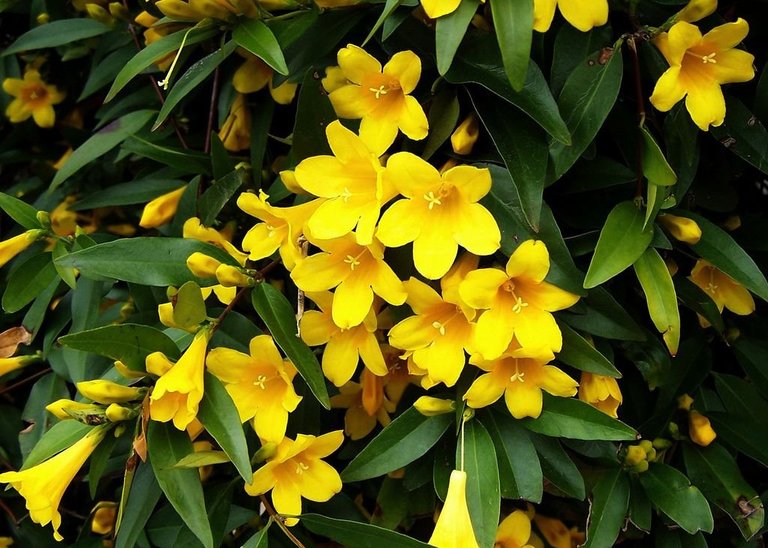
https://www.hindawi.com/journals/ecam/2011/362517/
Born in the South, Gelsemium sempervirens, commonly called the Carolina jessamine is a terrific native vine for Carolina landscapes. Admired for its sweetly scented, canary yellow flowers, this vine really puts on a show from February to April, depending on weather.
The golden, trumpet-shaped blooms are 1½ inches long and seen in small clusters, with narrow, glossy evergreen foliage. The foliage bronzes in winter.
Carolina jessamine is tolerant of wind, short periods of drought and moderately salt tolerant.
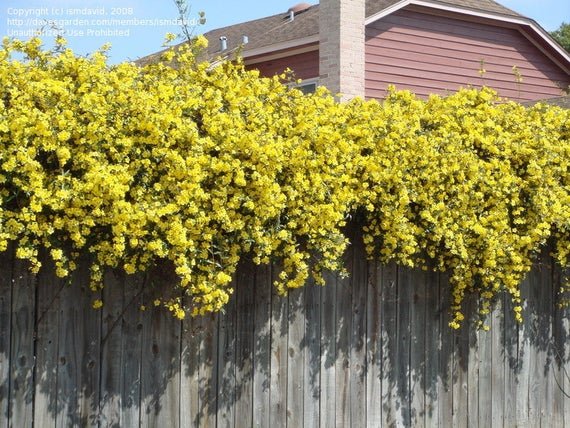
Carolina jessamine can be trained to arbors and trellises, and is often found in wooded areas growing up tree trunks. The jessamine has a modest growth rate until well-established; it generally takes three to four growing seasons for the vines to cover an average-sized arbor.
This landscape plant will become 20 feet or taller when allowed to grow untrained. Occasionally, older jessamine vines become top heavy or sparse. This can be remedied by pruning the vines soon after they finish flowering. The Carolina jessamine is the state flower of South Carolina.
source
Common Name: Carolina yellow jasmine
Type: Vine
Family: Gelsemiaceae
Native Range: Southern United States, Mexico, Guatemala
Zone: 7 to 10
Height: 12.00 to 20.00 feet
Spread: 3.00 to 6.00 feet
Bloom Time: February to April
Bloom Description: Yellow
Sun: Full sun
Water: Medium
Maintenance: Low
Flower: Showy, Fragrant
Culture
Winter hardy to USDA Zones 7-10 where it is best grown in moist, organically rich, well-drained soils in full sun. Tolerates light shade, but best flowering and growth occur in full sun. Plants will grow as a twining vine or if unsupported as a bushy ground cover. Plants may survive winter in the Missouri boot heel but not in St. Louis.
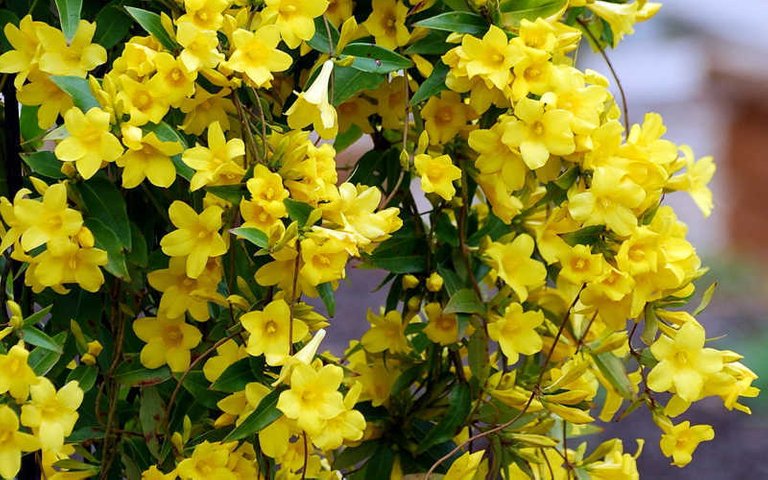
Noteworthy Characteristics
Gelsemium sempervirens, commonly called false jasmine or false jessamine, is an evergreen twining vine that is native from Virginia to Florida west to Texas and Central America. It is typically found in open woods, thickets and along roads. Bright, fragrant, funnel-shaped, yellow flowers (to 1.5” long) appear either solitary or in clusters (cymes) in late winter to early spring (February – April depending on location).
Source
Carolina Yellow Jessamine
Carolina yellow jessamine (or jasmine) is the state flower of South Carolina. This plant is a twining vine that is native to the Southeast US, so it is well-adapted to our LA climate. Carolina yellow jessamine can grow up to 3-6 meters high when given suitable climbing support. The leaves are evergreen and a beautiful dark green. The trumpet-shaped yellow flowers arise in clusters and sometimes have an orange center. The flowers are strongly scented and produce nectar that attracts a range of pollinators.
Historically, this plant was used as a topical to treat the symptoms of measles, tonsillitis, and headaches. However, all parts of this plant exude chemicals that are toxic to people and animals, so should not be consumed. The nectar is also toxic to honeybees, which may cause brood death when the nectar is gathered by the bees and brought back to their hive. Despite the potential hazards, this is a popular garden plant in the south and is frequently trained to cover walls.
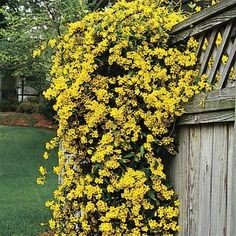
eing a native plant it tends to be hardy and well-adapted in the residential or commercial landscape. Established native plants can grow with little to no fertilizer and pesticides, and may require little to no irrigation. In this way, native plants generally help protect water resources, allowing gardeners to reduce fertilizers, pesticides, and irrigation practices which otherwise can contribute to stormwater runoff pollution and degradation of downstream water quality.
http://greenmandan.com/carolina-yellow-jessamine/
YELLOW JASMINE - "GELSEMIUM SEMPERVIRENS"
One of the South's most fragrant plants. Beautiful and easy to grow, yellow jasmine is a semi-evergreen climbing vine which blooms in early spring and again in the fall. The plant is known by several names, including Carolina jasmine, evening trumpetflower, yellow jessamine and its formal botanical name, Gelsemium sempervirens. Though it is lovely, all parts of the yellow jasmine plant are highly poisonous. The notion that the nectar from this plant poisons bees or contaminates honey is false. Bees are able to metabolize naturally occurring toxic nectars, into a safe food source for themselves and their brood. Read more about Green Chapels Bee Research here.
HISTORY:
The native Algonquin tribes of the Carolinas, made great use of this lovely plant. A tincture of the flowers in fermented fruit, was used to treat Malaria and other Fevers (or "Ague" from the Algonquin), a mosquito-born infectious disease. Malaria was a plague to early settlers in the Americas, into modern times, with the last case being reported in 1940. The Algonquins used their native medicines to survive diseases like Malaria for centuries, which speaks volumes to their effectiveness. The Algonquins also used Gelsemium Sempervirens as a weapon. They poisoned the water sources of their enemies, and administered a tea made from the leaves, to paralyze an enemy so that they might be tortured without losing consciousness.
In 2011, Gelsemium was used to poison and kill Chinese billionaire Long Liyuan. The plant was added to a stew by a disgruntled business associate. (Guangdong province)
GROWTH HABIT:
Yellow jasmine has fine, trailing tendrils which are easily trained up a trellis or other support. Individual vines can reach 15 to 20 feet in length within several years. New leaves appear just before the plant flowers. leaves darken to a bronze-green in winter. Leaves persist throughout the winter unless temperatures are unusually low.
http://www.wildthingsgrow.com/yellow-jessamine-gelsemium-sempervirens.html
Gelsemium sempervirens is a twining vine in the family Gelsemiaceae, native to subtropical and tropical America: Honduras, Guatemala, Belize, Mexico (Chiapas, Oaxaca, Veracruz, Puebla, Hidalgo), and southeastern and south-central United States (from Texas to Virginia). It has a number of common names including yellow jessamine or jasmine, Carolina jasmine or jessamine, evening trumpetflower, gelsemium and woodbine.

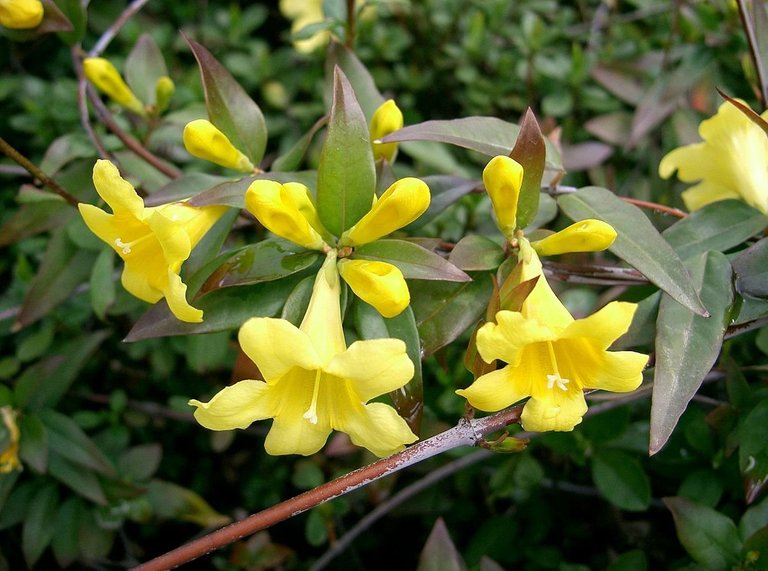

Source
Source
Source
Gelsemium sempervirens can grow to 3–6 m (9.8–19.7 ft) high when given suitable climbing support in trees, with thin stems. The leaves are evergreen, lanceolate, 5–10 cm (2.0–3.9 in) long and 1–1.5 cm (0.39–0.59 in) broad, and lustrous, dark green. The flowers are borne in clusters, the individual flowers yellow, sometimes with an orange center, trumpet-shaped, 3 cm (1.2 in) long and 2.5–3 cm (0.98–1.18 in) broad. Its flowers are strongly scented and produce nectar that attracts a range of pollinators. Source
magoo-2 found a series of multi accounts of a same owner is following your articles to cheat your generous rewards.
magoo-2 found these accounts are suspicious & can be multi accounts of a single owner. Conclusion is based on last 30 days transactions:
@alves @devid1996 @mhyeasin @sadikulaziz @msena @kilee @ripon1 @googlefighter @melianasagita @ashasikder @hichako
magoo-2
Check our latest multi comment spam update report
So pretty flower!There are more than 200 varieties of plants belonging to either the Oleaceae family of true jasmine or the Loganiaceae family of false jasmine. The flowers of the former are nontoxic if eaten. Within the Loganiaceae family, the flowers of gelsemium sempervirens Loganiaceae, also known as yellow jasmine, yellow jessamine or Carolina jasmine, are highly poisonous. When eaten they may cause a wide range of side effects in humans, animals and bees.
Carolina jasmine (gelsemium sempervirens) is a native plant common across the southeastern states. Blooming between December and May, its pleasant fragrance, climbing habit and abundant yellow trumpet-shaped flowers make it desirable enough as a garden plant that it's been named South Carolina's official state flower. However, every part of Carolina jasmine, including its flowers, is poisonous. Carolina jasmine contains gelseminine, gelsemoidin and gelsemine, alkaloids of the strychnine family, with the highest alkaloid concentrations found in the roots and flowers. The honey made from the flowers' nectar, according to both the Medical Toxicology of Natural Substances and the Mississippi Department of Wildlife, is potentially toxic to humans.
Source:
https://www.hunker.com › side-effects-of...
magoo-2 found a series of multi accounts of a same owner is following your articles to cheat your generous rewards.
magoo-2 found these accounts are suspicious & can be multi accounts of a single owner. Conclusion is based on last 1 year transactions:
@rupok @sarahmcdowell2 @razu788 @tangera
magoo-2
Check our latest multi comment spam update report
Spam Bot Detection found a series of multi accounts of a same owner is following your articles to cheat your generous rewards.
@rupok @sarahmcdowell2 @razu788 @tangera
Yellow colors flower are eye catching . But this plant is unique. It used in fragrances and medicines . These qualities makes it diffrent . Thanks for the blog
With stems that can exceed 20 feet in length, Carolina jessamine (Gelsemium sempervirens) climbs over anything it can twine its wiry stem around. Plant it on trellises and arbors, along fences or under trees with loose canopies.
The glossy leaves stay green all year, providing dense coverage for the supporting structure. Carolina jessamine vines are covered with clusters of fragrant, yellow flowers in late winter and spring.
The flowers are followed by seed capsules that ripen slowly over the remainder of the season. If you want to collect a few seeds to start new plants, pick the capsules in fall after the seeds inside have turned brown.
Air dry them for three or four days and then remove the seeds. They are easy to start indoors in late winter or outdoors in late spring when the soil is thoroughly warm.
source
There are more than 200 varieties of plants belonging to either the Oleaceae family of true jasmine or the Loganiaceae family of false jasmine. The flowers of the former are nontoxic if eaten. Within the Loganiaceae family, the flowers of gelsemium sempervirens Loganiaceae, also known as yellow jasmine, yellow jessamine or Carolina jasmine, are highly poisonous. When eaten they may cause a wide range of side effects in humans, animals and bees.
source
Thanks for the information sir this is a species of vine native to Central America and North America.
Festooning fences and trees with its slender vines and bright yellow flowers, Yellow Jessamine, sometimes called Carolina Jessamine, is one of the most beautiful vines of the South.
These trailing or climbing woody vines are quite common in the Southeast in open woodlands and thickets, and along roadsides; and the blossoms occur in sufficient numbers to make the plant quite showy.
The evergreen leaves are in pairs one to three inches long, entire, and pointed at the tips. Yellow Jessamine begins blooming in February to early March. The fragrant flowers are funnel-shaped with five spreading, rounded lobes. It is easy to grow and can be used in many ways. Do not be tempted to chew the leaves as they contain a toxic compound.
Several different shrubs and vines with fragrant flowers have been called Jasmine. This plant gets its botanical name from the Latinized form of gelsemina, the Italian name for the true jasmine.
It is the State Flower of South Carolina.
source
Gelsemium sempervirens
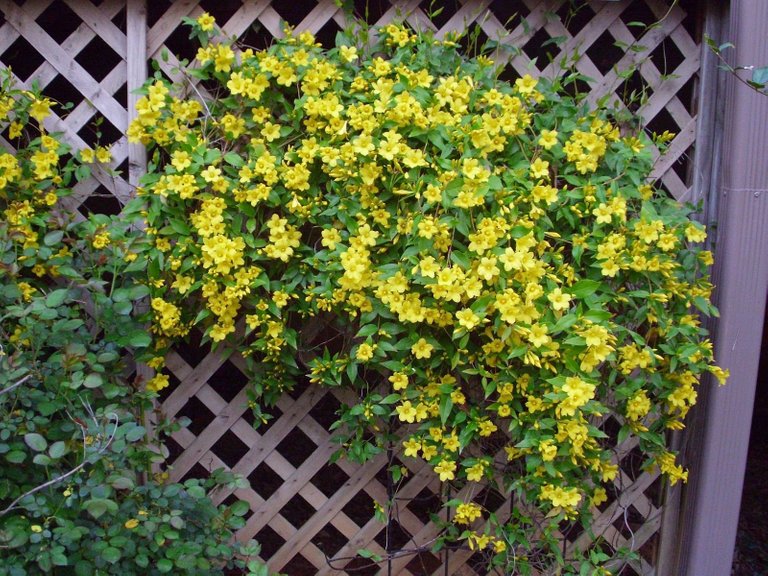
Common Name: Carolina yellow jasmine
Type: Vine
Family: Gelsemiaceae
Native Range: Southern United States, Mexico, Guatemala
Zone: 7 to 10
Height: 12.00 to 20.00 feet
Spread: 3.00 to 6.00 feet
Bloom Time: February to April
Bloom Description: Yellow
Sun: Full sun
Water: Medium
Maintenance: Low
Flower: Showy, Fragrant
Noteworthy Characteristics
Gelsemium sempervirens, commonly called false jasmine or false jessamine, is an evergreen twining vine that is native from Virginia to Florida west to Texas and Central America. It is typically found in open woods, thickets and along roads. Bright, fragrant, funnel-shaped, yellow flowers (to 1.5” long) appear either solitary or in clusters (cymes) in late winter to early spring (February – April depending on location). Flowers often serve as a demonstrative signal that winter is coming to an end. As a vine, false jasmine grows on wiry reddish-brown stems to 20’ long. As a bushy ground cover, it grows to 3’ tall and will sprawl somewhat indefinitely by runners. Shiny, lanceolate, light green leaves (to 1-3” long) are evergreen, but may develop yellow to purple hues in winter. Plants are semi-evergreen toward the northern limits of their growing range. Flowers and foliage are poisonous if ingested. The name of this vine is varyingly spelled as jasmine or jessamine. Carolina jessamine was named the official flower of South Carolina in 1924.
http://www.missouribotanicalgarden.org/PlantFinder/PlantFinderDetails.aspx?kempercode=c519
Kingdom : Plant
Phylum : Magnoliophyta
Class : Magnoliopsida
Order : Gentianales
Family : Loganiaceae
Genus : Gelsemium
Species : sempervirens (L.) Aiton
Common name : Yellow jessamine, evening trumpet flower
source
Natural History
Tubular flowers of yellow jessamine in early spring
Photo credit: Mary Keim (Flickr ID Mary Keim).
Used under a Creative Commons license. Creative Commons Attribution-Noncommercial-Share Alike 2.0 Generic License
Yellow jessamine is a climbing vine that is native to the southeastern United States. It is known by several names, including Carolina jessamine, poor man's rope, or yellow jasmin.
It has also been known as "The Pride of Augusta," because it is found abundantly near Augusta, Georgia. Yellow jessamine is the state flower of South Carolina and it appears on that state's quarter along with the Carolina wren and the cabbage palmetto.
Yellow jessamine is particularly noticeable because it has showy, yellow flowers that appear in late winter or early spring when few other plants are in bloom. In some strains of the plant, the flowers are very fragrant and send a sweet, prevailing scent through the wintery woods.
source